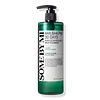What's inside
What's inside
 Key Ingredients
Key Ingredients

 Benefits
Benefits

 Concerns
Concerns

 Ingredients Side-by-side
Ingredients Side-by-side

Water
Skin ConditioningLauric Acid
CleansingGlycerin
HumectantPotassium Hydroxide
BufferingMyristic Acid
CleansingSodium Chloride
MaskingSodium C14-16 Olefin Sulfonate
CleansingLauryl Hydroxysultaine
CleansingBenzyl Glycol
SolventCoco-Betaine
CleansingSalicylic Acid
MaskingEucalyptus Globulus Leaf Oil
PerfumingButylene Glycol
HumectantEthylhexylglycerin
Skin ConditioningMelia Azadirachta Leaf Extract
Skin ConditioningDisodium EDTA
Coptis Japonica Root Extract
Skin Conditioning1,2-Hexanediol
Skin ConditioningMelia Azadirachta Flower Extract
Skin ConditioningMelaleuca Alternifolia Leaf Water
AntimicrobialEthyl Hexanediol
SolventCentella Asiatica Extract
CleansingAsiaticoside
AntioxidantMadecassic Acid
Skin ConditioningGluconolactone
Skin ConditioningCitric Acid
BufferingAsiatic Acid
Skin ConditioningMandelic Acid
AntimicrobialMadecassoside
AntioxidantArtemisia Vulgaris Extract
Skin ConditioningWater, Lauric Acid, Glycerin, Potassium Hydroxide, Myristic Acid, Sodium Chloride, Sodium C14-16 Olefin Sulfonate, Lauryl Hydroxysultaine, Benzyl Glycol, Coco-Betaine, Salicylic Acid, Eucalyptus Globulus Leaf Oil, Butylene Glycol, Ethylhexylglycerin, Melia Azadirachta Leaf Extract, Disodium EDTA, Coptis Japonica Root Extract, 1,2-Hexanediol, Melia Azadirachta Flower Extract, Melaleuca Alternifolia Leaf Water, Ethyl Hexanediol, Centella Asiatica Extract, Asiaticoside, Madecassic Acid, Gluconolactone, Citric Acid, Asiatic Acid, Mandelic Acid, Madecassoside, Artemisia Vulgaris Extract
Water
Skin ConditioningGlycerin
HumectantRosmarinus Officinalis Leaf Water
MaskingNiacinamide
SmoothingCetearyl Alcohol
EmollientEthylhexyl Palmitate
EmollientPropylene Glycol
HumectantDimethicone
EmollientButyrospermum Parkii Oil
EmollientGlyceryl Stearate
EmollientPhenoxyethanol
PreservativeParfum
MaskingPEG-40 Stearate
EmulsifyingCeteareth-20
CleansingAllantoin
Skin ConditioningMethylparaben
PreservativeAcrylates/C10-30 Alkyl Acrylate Crosspolymer
Emulsion StabilisingSodium Polyacrylate
AbsorbentTriethanolamine
BufferingEthylhexyl Cocoate
EmollientDisodium EDTA
Butylene Glycol
HumectantRosmarinus Officinalis Leaf Oil
MaskingPPG-3 Benzyl Ether Myristate
EmollientPolysorbate 20
EmulsifyingLactic Acid
BufferingPentylene Glycol
Skin ConditioningAscorbic Acid
AntioxidantAvena Sativa Kernel Extract
AbrasiveAlpha-Arbutin
AntioxidantSodium Acetylated Hyaluronate
HumectantSodium Hyaluronate
HumectantSodium Hyaluronate Crosspolymer
HumectantHydrolyzed Sodium Hyaluronate
Skin ConditioningEthylhexylglycerin
Skin ConditioningWater, Glycerin, Rosmarinus Officinalis Leaf Water, Niacinamide, Cetearyl Alcohol, Ethylhexyl Palmitate, Propylene Glycol, Dimethicone, Butyrospermum Parkii Oil, Glyceryl Stearate, Phenoxyethanol, Parfum, PEG-40 Stearate, Ceteareth-20, Allantoin, Methylparaben, Acrylates/C10-30 Alkyl Acrylate Crosspolymer, Sodium Polyacrylate, Triethanolamine, Ethylhexyl Cocoate, Disodium EDTA, Butylene Glycol, Rosmarinus Officinalis Leaf Oil, PPG-3 Benzyl Ether Myristate, Polysorbate 20, Lactic Acid, Pentylene Glycol, Ascorbic Acid, Avena Sativa Kernel Extract, Alpha-Arbutin, Sodium Acetylated Hyaluronate, Sodium Hyaluronate, Sodium Hyaluronate Crosspolymer, Hydrolyzed Sodium Hyaluronate, Ethylhexylglycerin
 Reviews
Reviews

Ingredients Explained
These ingredients are found in both products.
Ingredients higher up in an ingredient list are typically present in a larger amount.
Butylene Glycol (or BG) is used within cosmetic products for a few different reasons:
Overall, Butylene Glycol is a safe and well-rounded ingredient that works well with other ingredients.
Though this ingredient works well with most skin types, some people with sensitive skin may experience a reaction such as allergic rashes, closed comedones, or itchiness.
Learn more about Butylene GlycolDisodium EDTA plays a role in making products more stable by aiding other preservatives.
It is a chelating agent, meaning it neutralizes metal ions that may be found in a product.
Disodium EDTA is a salt of edetic acid and is found to be safe in cosmetic ingredients.
Learn more about Disodium EDTAEthylhexylglycerin (we can't pronounce this either) is commonly used as a preservative and skin softener. It is derived from glyceryl.
You might see Ethylhexylglycerin often paired with other preservatives such as phenoxyethanol. Ethylhexylglycerin has been found to increase the effectiveness of these other preservatives.
Glycerin is already naturally found in your skin. It helps moisturize and protect your skin.
A study from 2016 found glycerin to be more effective as a humectant than AHAs and hyaluronic acid.
As a humectant, it helps the skin stay hydrated by pulling moisture to your skin. The low molecular weight of glycerin allows it to pull moisture into the deeper layers of your skin.
Hydrated skin improves your skin barrier; Your skin barrier helps protect against irritants and bacteria.
Glycerin has also been found to have antimicrobial and antiviral properties. Due to these properties, glycerin is often used in wound and burn treatments.
In cosmetics, glycerin is usually derived from plants such as soybean or palm. However, it can also be sourced from animals, such as tallow or animal fat.
This ingredient is organic, colorless, odorless, and non-toxic.
Glycerin is the name for this ingredient in American English. British English uses Glycerol/Glycerine.
Learn more about GlycerinWater. It's the most common cosmetic ingredient of all. You'll usually see it at the top of ingredient lists, meaning that it makes up the largest part of the product.
So why is it so popular? Water most often acts as a solvent - this means that it helps dissolve other ingredients into the formulation.
You'll also recognize water as that liquid we all need to stay alive. If you see this, drink a glass of water. Stay hydrated!
Learn more about Water